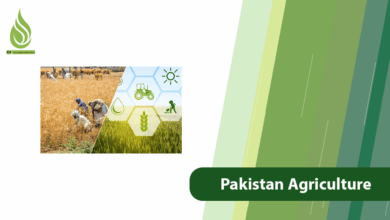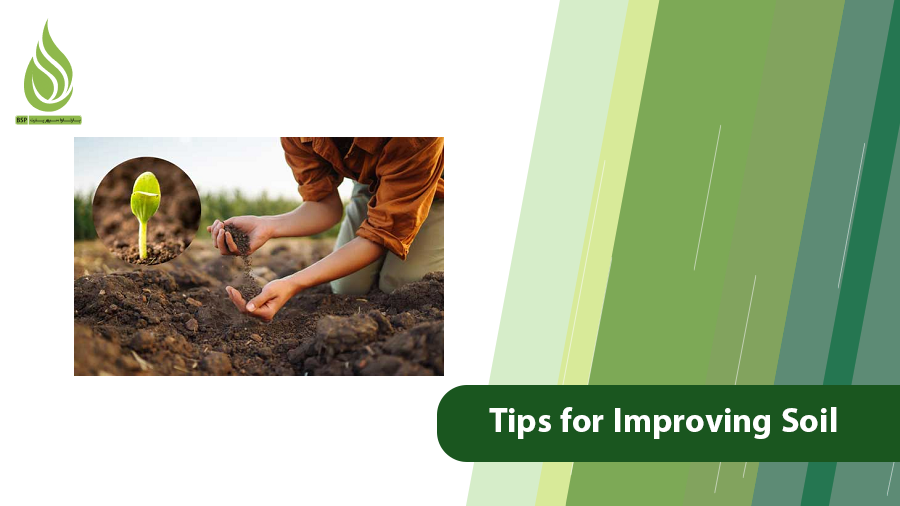
Essential Tips for Improving Soil Texture
Sometimes, despite a farmer’s hard work, a garden or field fails to achieve sufficient productivity. In these cases, it’s critical to identify the root cause. One major reason for low crop yields is poor soil texture. When soil texture is unsuitable, water and nutrient absorption are disrupted, preventing plants from thriving. The solution? Improving soil texture.
Improving soil texture creates a more favorable environment for root growth. Proper adjustments boost fertility and improve water retention. Below, we’ll explain practical methods to optimize soil texture. Let’s dive in!
Why Improve Soil Texture?
Soil texture is a fundamental characteristic that directly impacts soil quality and productivity. Among common soil types—clay, silt, and sand—each behaves differently:
- Clay soils hold water well but drain poorly.
- Sandy soils drain quickly but struggle to retain moisture.
- Larger particles in sandy soils also allow better aeration, which is vital for root growth and microbial activity.
Soil texture also influences nutrient retention and availability. For example, clay soils trap nutrients effectively, but plants may struggle to absorb them. Additionally, texture affects microbial health, root development, and overall agricultural potential. In short, soil texture dictates the biological conditions of the soil and its ability to sustain healthy crops.

Every soil type has its own pros and cons. Most plants struggle to thrive in uniform soil, making soil texture improvement essential. Soil modification refers to adjustments made before planting to alter the soil’s texture. Without a suitable growing environment, your efforts won’t achieve maximum impact. By improving soil texture, farmers can create better conditions for plant growth, support sustainable farming, and protect the environment.
Key Benefits of Soil Texture Improvement:
- Boosts crop quality and quantity.
- Reduces erosion and conserves water.
- Enhances soil structure, promoting beneficial bacteria and microbial activity.
- Improves drainage and aeration.
- Reduces plant diseases.
- Minimizes excessive chemical fertilizer use by tailoring solutions to the soil’s needs.
Identifying Soil Texture: How to Assess Your Soil
Understanding your soil’s texture is a critical first step in effective soil management. By evaluating your soil using practical methods (discussed next), you’ll gain a clearer picture of its characteristics. This knowledge allows you to implement targeted improvements, ensuring healthier crops and long-term productivity.
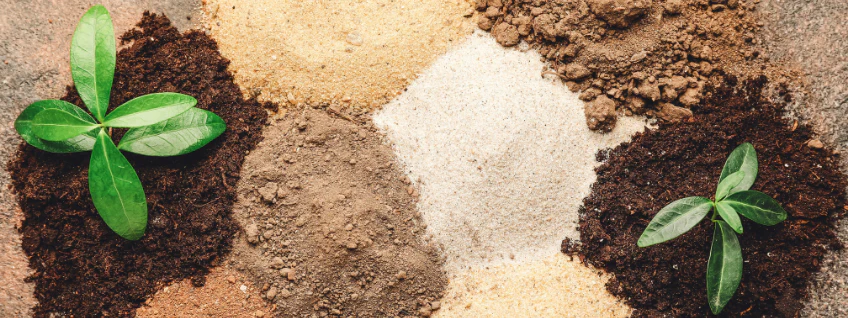
Key Techniques for Identifying Soil Texture
Understanding soil texture is essential for effective land management. Here are the most reliable methods to determine it:
- Visual Inspection
- Color: Soil color hints at its texture and nutrient content. Light-colored soils typically have higher sand content, while darker soils suggest more organic matter and clay.
- Structure: Clay soils feel smooth and sticky when wet, whereas sandy soils have coarse, loose grains.
- Lab Testing
Professional soil testing in specialized labs provides precise insights into soil type and quality. - Stickiness Test
- Mix soil with water to form a soft ball.
- Press it gently. If it holds its shape (sticky), it’s likely clay. If it crumbles, the soil is sandy or silty.
- Water Absorption Test
- Place dry soil in water and time how long absorption takes.
- Fast absorption indicates sandy soil; slow absorption suggests clay.
- Sieve Test
- Dry the soil and sift it through stacked sieves (2 mm, 0.5 mm, 0.25 mm).
- Measure the particles retained in each sieve. The ratio of sand, silt, and clay determines the soil texture.
Characteristics of Soil Types (Sand, Silt, Clay)
Soil texture depends on the mix of particle sizes. Let’s break down the unique characteristics of each soil type to understand their strengths and challenges:
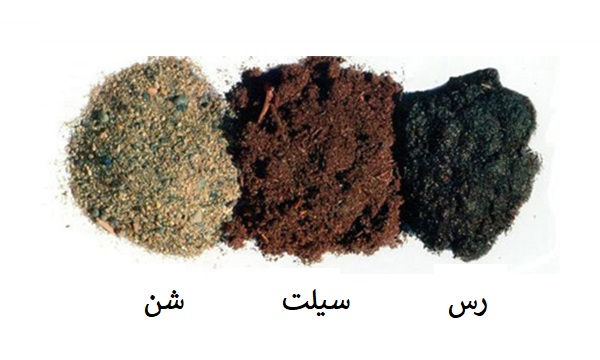
- Sandy Soil:
- Physical Traits:
Large, visible grains with a gritty, coarse texture. Loose and less compacted. - Water Retention:
Drains water rapidly due to large gaps between particles. Poor at retaining moisture. - Nutrient Availability:
Low nutrient-holding capacity. Plants may require frequent fertilization. - Aeration:
Excellent airflow due to its loose structure, promoting healthy root development.
- Physical Traits:
- Clay Soil
- Physical Traits:
Fine, sticky particles that feel smooth and moldable when wet. - Water Retention:
Holds water exceptionally well, often leading to waterlogging. - Nutrient Availability:
Rich in nutrients, but they’re often “locked” and hard for plants to absorb. - Aeration:
Poor airflow due to dense packing. Risks root suffocation in wet conditions.
- Physical Traits:
- Silt Soil
- Physical Traits:
Particles smaller than sand but larger than clay. Smooth, silky texture. - Water Retention:
Retains moisture better than sand but drains more efficiently than clay. Ideal for agriculture. - Nutrient Availability:
Holds and releases nutrients effectively, supporting robust plant growth. - Aeration:
Balanced airflow and moisture retention, though drainage issues can arise in heavy rain.
- Physical Traits:
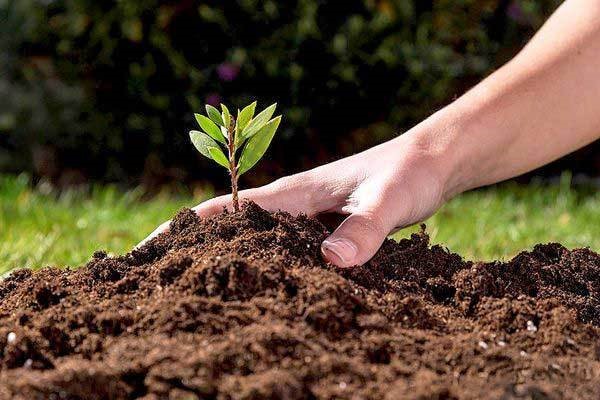
Methods to Improve Soil Texture
Soil amendments are materials added to soil to enhance its physical properties, including structure and drainage. These amendments are classified into three categories:
- Plant-based (wood chips, shredded straw, hay, sawdust, compost),
- Animal-based (cow manure, sheep manure, etc.), and
- Chemical (e.g., vermiculite, perlite, sand).
Additional methods for improving soil structure include crop rotation. Cover crops help boost organic matter in the soil and prevent erosion. Similarly, drip irrigation systems can reduce water evaporation and improve water use efficiency.
Heavy, compacted soils and overly light soils are unsuitable for agriculture. Therefore, soil texture must be adjusted using appropriate techniques. The goal of soil texture improvement is to address the soil’s shortcomings as effectively as possible. The ideal soil for farming is loamy soil, which consists of a balanced mixture of sand, silt, and clay. This combination provides the benefits of all three soil textures. Key characteristics of loamy soil include moisture retention, nutrient retention, proper aeration, and adequate drainage to allow air and water to reach plant roots.
The first step in improving soil texture is identifying your soil type. This knowledge helps determine what amendments are needed and how the soil will respond to adjustments. For example, in sandy soils, many amendments wash away quickly due to leaching. As a result, larger quantities of amendments may be required to achieve the desired effect.
Amending Heavy (Clay) Soil Texture
Soil classified as “heavy” or clay soil contains more than 50% clay particles. This type of soil is sticky, poorly permeable, and challenging to work with. Amending clay soil aims to enhance its permeability, aeration, and water retention capacity. Improving heavy, clay-rich soil texture requires a combination of natural and chemical techniques. By applying these methods, soil quality and fertility can be significantly improved.

Here are effective techniques to improve clay soil:
- Add Organic Matter: Incorporate organic materials like animal manure or compost to enhance soil structure and boost microbial activity. These additions improve aeration and permeability.
- Mix with Sandy or Lighter Soils: Blending clay soil with sandy or lighter-textured soil helps balance its texture and reduces stickiness.
- Apply Mulch: Covering the soil surface with mulch (e.g., straw, dried leaves, or gravel) helps reduce evaporation, retain moisture, and improve soil conditions.
- Plant Deep-Rooted Crops: Growing plants with deep roots naturally breaks up compacted soil and enhances aeration.
- Optimize Irrigation: Proper watering schedules prevent waterlogging and soil compaction. Drip irrigation is the most efficient option.
- Use Chemical Amendments: Apply materials like calcium sulfite or gypsum to improve permeability and soil structure.
Amending Light (Sandy) Soil Texture
Sandy soil amendment focuses on improving water/nutrient retention and preventing erosion. Sandy soils have large particles with excessive spacing, leading to rapid drainage, nutrient leaching, and drought susceptibility. Effective methods include:
- Add Organic Matter: Enrich sandy soil with organic fertilizers (e.g., compost) to boost water/nutrient retention and microbial activity.
- Incorporate Heavy Soils: Mix sandy soil with clay-rich soil to enhance moisture-holding capacity.
- Apply Water-Retaining Polymers: Use chemical additives like hydrogels to increase the soil’s ability to retain water.
- Use Mulch: Mulching helps conserve moisture and stabilize soil temperature.
- Plant Deep-Rooted Species: These plants improve soil structure and water infiltration.
- Manage Irrigation: Adjust watering practices to maintain consistent moisture and prevent drought stress.
By combining these strategies, both clay and sandy soils can be transformed into fertile, productive growing environments.
